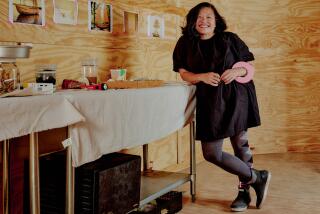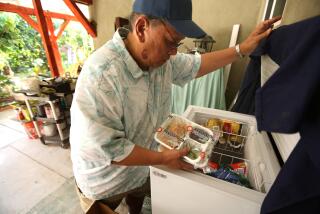The Homeless Get a Taste of Haute Cuisine
- Share via
SAN DIEGO — Poached salmon with caviar and grilled baby vegetables is hardly a typical meal for the homeless families living at the Southeast Emergency Quarters in Southeast San Diego.
But one recent evening, residents dined on this chic cuisine courtesy of chefs at the Hyatt Islandia, who had 100 extra servings of fish, vegetables, salad and dessert after a large luncheon.
Six months ago, those elegant leftovers would have ended up in the garbage. Now, when the chef has extra food, he calls Marie Hinkley and her husband, Hank, who deliver unused food from the city’s most elegant restaurants to some of its poorest neighborhoods.
Love’s Gift, the nonprofit agency Hinkley founded, distributes about 300 pounds of perishable food a week to 20 agencies such as Southeast Emergency Quarters that shelter the homeless.
“The food is good. It isn’t old and it’s healthy,” said Arlena Foster, the shelter’s director.
Without twice-a-week contributions from Love’s Gift, Foster said, she would have to spend more money from the shelter’s slender budget to feed the home’s 30 residents.
Just a few blocks away at Christian Mission, men have lined up early in hopes of getting an evening meal. The Hinkleys deliver the remaining fish and vegetables to the mission’s back door, not minding that they have to step over broken liquor bottles to reach the entrance.
“We’ve really progressed very fast. I’m pleased,” said Hinkley, who founded Love’s Gift in January after reading about a similar program in Minneapo lis called “Twelve Baskets.” At least 40 other cities across the nation have similar food-salvation programs under different names.
Long a restaurant manager herself, Hinkley had seen waste in kitchens. Although good chefs try to salvage all they can, they invariably have leftover banquet food or other items that cannot be served to regular diners. Though the food is untouched, it is often thrown out.
After reading about Twelve Baskets, the former restaurateur said she felt foolish for not thinking of the idea herself.
“I wondered why I wasn’t doing something like that,” she said.
It wasn’t long before she was. Hinkley left her job as a manager at Cilantros Restaurant in Del Mar to start Love’s Gift. The only stumbling block to the program was lifted in January when a state law removed restaurant liability for their donations. Love’s Gift made its first pickup in April.
Hinkley works closely with chefs and cooks from restaurants and hospitals throughout San Diego. Charles Lewis, executive chef at the Hyatt Islandia on Mission Bay, calls Hinkley whenever he ends up with extra meals.
“I just don’t like to see waste,” he said. “To me, food is an art. It’s my profession. I just don’t like to see it wasted. My mother used to tell me that wasting food is a sin, and it is.”
During weeks when the Hyatt kitchen is bare, Lewis makes 5 or 10 gallons of soup for Love’s Gift. He’ll also cook soup when a mission calls Hinkley because it hasn’t had food in two or three days.
“It makes me feel good just to give something away, even if it’s just a few rolls and some soup,” Lewis said. He became used to donating leftover food when he worked at the Hyatt on Union Square in downtown San Francisco. A nearby rescue mission often had as many as 900 people lined up for meals, so Lewis started donating whatever he had.
Hinkley’s service is not limited to gourmet leftovers.
At the Stardust Hotel in Mission Valley, Love’s Gift picked up a large bucket of fried chicken, some tamales, two bags of rolls and two containers of soup after visiting the Hyatt. Hank also visits a produce distributor and French bakery regularly for vegetables and bread. Once, a grower in El Centro gave 4 tons of onions.
The Hinkleys first collection and delivery in April consisted of 20 pounds of food. By next spring, they hope to be distributing 2,000 pounds a week on a regular basis.
The only thing holding them back from collecting more food now is the lack of a refrigerated truck--or any truck, for that matter.
Each afternoon Hank loads his silver compact car with four plastic coolers to hold the fresh fruits, vegetables and entrees offered by the restaurants. He often makes two or three trips a day, filling his small car with food and delivering it to a few of the agencies that Love’s Gift serves. Then he visits more restaurants or hospital kitchens and loads up again.
The couple spends about $200 a month on gas. And, although the program has about 10 regular volunteers and all the food it can handle, it gets few monetary donations to offset the cost.
The Hinkleys may get some county help for the program. In June, the Board of Supervisors voted unanimously to support Love’s Gift and offer assistance through the county Department of Social Services. The local restaurant association has also endorsed the work of Love’s Gift.
County administrator Georgia Tate hopes the organization can earn a state or federal grant to buy a refrigerated truck. She’s helping Hinkley send out press releases and information about Love’s Gift in hopes of getting donations and making the public aware of the perishable foods program.
As for Hinkley, she said she eventually hopes to draw a salary for administering Love’s Gift. Working full time out of her small office in the basement of a Point Loma church, Hinkley discusses the program as if it’s something anyone could--and would --do.
“Something needed to be done,” Hinkley said simply. “And I knew I could make it work.”
More to Read
Eat your way across L.A.
Get our weekly Tasting Notes newsletter for reviews, news and more.
You may occasionally receive promotional content from the Los Angeles Times.










